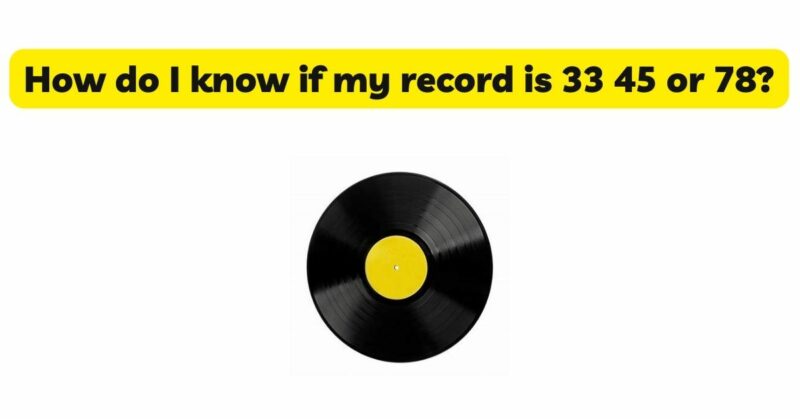Vinyl records have regained popularity, captivating music enthusiasts with their warm, analog sound and tactile experience. One crucial aspect of vinyl records is their rotational speed, indicated by RPM (revolutions per minute). The RPM determines how fast the record should spin on the turntable for optimal playback. In this article, we will explore how to identify the RPM of your vinyl record, providing you with the necessary knowledge to ensure accurate playback and an enjoyable listening experience.
- Visual Indicators: The RPM of a vinyl record is often indicated on the record label or the outer edge of the record itself. Look for a small printed number or symbol that represents the speed. The most common symbols include “33,” “45,” or “78,” corresponding to 33 1/3 RPM, 45 RPM, and 78 RPM, respectively. These numbers are typically displayed prominently and can be easily identified with a quick visual inspection.
- Record Label Information: The record label is an essential source of information when determining the RPM of a vinyl record. Look for any text or symbols printed on the label that indicate the speed. Some labels explicitly state the RPM next to the catalog number or alongside other record information. Additionally, the record sleeve or cover may provide details about the speed of the record, so be sure to check these sources as well.
- Runout Groove Etchings: The runout groove, also known as the dead wax, is the space between the last track on the record and the label. It often contains etchings or markings that provide additional information about the record, including the RPM. Carefully inspect the runout groove area, using a strong light source and a magnifying glass if necessary. Look for etched numbers or symbols that indicate the speed, such as “33,” “45,” or “78.” These etchings are typically found near the center spindle hole or along the outer edge of the groove.
- Diameter and Center Hole Size: While not foolproof, the diameter and center hole size of the vinyl record can provide some clues about its speed. Most 12-inch records are designed to play at 33 1/3 RPM, while 7-inch records are commonly associated with 45 RPM. However, this is not always the case, as there can be exceptions and variations. Additionally, some 78 RPM records may have larger center holes to accommodate the wider spindle used for those speeds. Although these indicators can provide some initial guidance, they should not be relied upon solely, as there are exceptions and variations among different releases and genres.
- External Sources: If you are unsure about the RPM of a particular vinyl record, external sources can be helpful in identifying the speed. Online databases, discography websites, and forums dedicated to vinyl records can provide valuable information. Enter the artist name, album title, and catalog number into these resources to find specific details about the record, including its RPM. Additionally, consulting with experienced vinyl collectors or visiting record stores with knowledgeable staff can also provide guidance and assistance in identifying the correct speed of your record.
- Test Playback: If you are still uncertain about the RPM of a vinyl record, a practical approach is to test its playback on a turntable. Set your turntable to the most common speeds, 33 1/3 RPM and 45 RPM, and play the record accordingly. Listen carefully to the playback and pay attention to any distortions, pitch variations, or abnormal sounds. If the record sounds noticeably slower or faster than it should, this may indicate that you need to try a different speed.
- Uncommon Speeds: While the vast majority of vinyl records are either 33 1/3 RPM or 45RPM, it’s important to note that there are some records that play at less common speeds, such as 78 RPM. These records are primarily from the early days of vinyl and are less prevalent in contemporary releases. If you come across a record that doesn’t match the typical 33 1/3 RPM or 45 RPM speeds, it may be a 78 RPM record, especially if it is from the early 20th century or labeled as such.
Conclusion: Identifying the RPM of your vinyl record is crucial for proper playback and to ensure an enjoyable listening experience. Visual indicators, such as printed numbers or symbols on the record label or outer edge of the record, are the primary sources of information. The runout groove etchings and information on the record label or sleeve can also provide clues about the speed. Additionally, considering the diameter and center hole size of the record, while not definitive, can offer some insights. External sources, such as online databases, discography websites, and expert collectors, can provide further information and guidance.If in doubt, test the playback of the record on your turntable, paying attention to any distortions or variations in pitch. This can help determine the correct speed for optimal playback. While most vinyl records are either 33 1/3 RPM or 45 RPM, it’s important to be aware that less common speeds, such as 78 RPM, exist, especially in older records.By understanding how to identify the RPM of your vinyl records, you can ensure that you set your turntable to the appropriate speed and experience the music as intended. So go ahead, explore your vinyl collection, and enjoy the analog pleasures that vinyl records have to offer.


